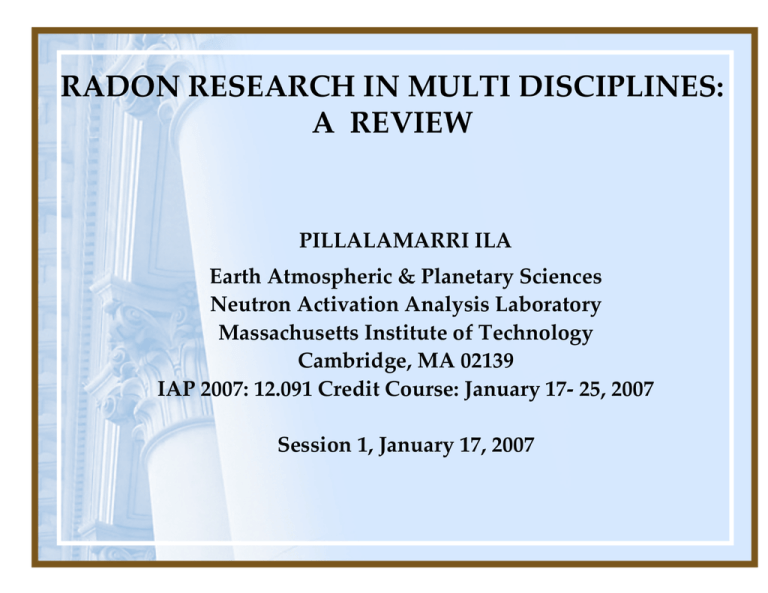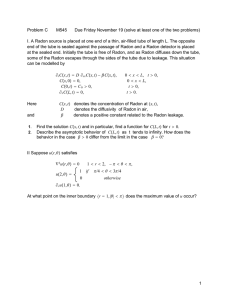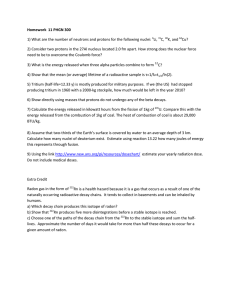RADON RESEARCH IN MULTI DISCIPLINES: A REVIEW
advertisement

RADON RESEARCH IN MULTI DISCIPLINES:
A REVIEW
PILLALAMARRI ILA
Earth Atmospheric & Planetary Sciences
Neutron Activation Analysis Laboratory
Massachusetts Institute of Technology
Cambridge, MA 02139
IAP 2007: 12.091 Credit Course: January 17‐ 25, 2007
Session 1, January 17, 2007
COURSE OUTLINE
I.
II.
III.
IV.
V.
Fundamentals of radon physics: review
Radon research in geology
Radon research in radiation biology
Radon research in medicine
Radon research in health physics
Earth & Planetary Science
Radon research in multi disciplines ‐
summary
Student Presentations Radioactivity Laboratory demonstration
January 17, 2007: IAP 2007: 12.091 Session 1: P. ILA
2
DETAILED COURSE WORK
The course work involves the following:
1.
January 17, 19, 22, 24, 26 1‐3 PM
5 sessions each of 2 hours ‐ 25%
2.
Study assignments – 4 ‐ 20%
3.
Project
Literature Survey – Writing a report ‐ 30%
4. Project Presentation
‐ 25%
Required percentage to pass this course is 95%
Grading: P/F
January 17, 2007: IAP 2007: 12.091 Session 1: P. ILA
3
Session 1
Radon &
Radiation Physics
Review
January 17, 2007: IAP 2007: 12.091 Session 1: P. ILA
4
Session 1
January 17, 2007
Objective 1 of 2
1. Radioactivity and Radiation Review
1.1 Alpha, Beta and Gamma radiation
1.2 Ions and ionizing radiation
2. Radon characteristics –
Uranium 238 decay series
3. Radon decay products –
Radon 222 decay sequence
January 17, 2007: IAP 2007:
12.091
Session 1: P. ILA
5
Session 1
January 17, 2007
Objective 2 of 2
4. Dynamic Equilibrium
5. Equilibrium Ratio
6. Measurement Units
6.1 Picocuries per liter &
Becquerel per cubic meter
6.2 Working Level and Working Level Month
7. Facts of Radon – An Overview
http://ocw.mit.edu/OcwWeb/Earth--Atmospheric-and-Planetary-Sciences/12-091January--IAP-2006/LectureNotes/index.htm Session2a.pdf
January 17, 2007: IAP 2007:
12.091
Session 1: P. ILA
6
1. Review of radioactivity and radionuclides concepts
Atomic Nucleus
Material
Compounds
Elements
Atoms
(Neutrons + Protons) + Electrons
{Nucleus}
Element X is depicted by
A
A = Mass Number
X
N = Neutron Number
Z N
Z = Atomic Number
(Proton Number)
A = Z+N
January 17, 2007: IAP 2007: 12.091
Session 1: P. ILA
7
1. Review of radioactivity and radionuclide concepts …
Radio-isotopes & Radio-nuclides
Mass
Neutron 1.008665 u
Proton 1.007277 u
Electron 0.000548 u
Charge
No electrical charge
Positive charge
Negative charge
(Ref: Basic Nuclear Engineering, A. R. Foster and R. L. Wright, Jr.,
Appendix B, pp 461)
Nuclides: Characterized by atomic number Z and mass number A.
Isotope – Same Z number, but different N.
59
60
Ex: Co,
Co.
27 32 27 33
Nuclides: Stable and Radioactive
Radioactive Nuclides: Naturally occurring and Artificially produced .
January 17, 2007: IAP 2007: 12.091
Session 1: P. ILA
8
1. Review of radioactivity and radio-nuclides concepts …
1.1 Alpha, beta and gamma radiation
Alpha decay followed by gamma decay:
Alpha particle is
234
4
2
He .
2
230
U
92 142
Th
+ α+γ.
90 140
234
The unstable isotope
230
U decays to
Th by alpha and
92
90
gamma radiation. The atomic number decreases by 2 and
mass number by 4.
January 17, 2007: IAP 2007: 12.091
Session 1: P. ILA
9
Alpha decay of
234U
to
230Th
Table 1: Alpha decay of 234U to 230Th (shown in the format of chart of nuclides).
The atomic number Z reduces by 2.
The neutron number N reduces by 2.
The mass number A reduces by 4.
January 17, 2007: IAP 2007: 12.091
Session 1: P. ILA
10
1. Review of radioactivity and radio-nuclides concepts …
1.1 Alpha, beta and gamma radiation …
Beta decay followed by gamma decay.
Beta particle is electron ejected by excited nuclei.
Their charge can be positive or negative.
40
K
19 21
40
Ca
20
+ β + γ.
20
The radioactive isotope 40K decays to 40Ca
by beta and gamma radiation. Neutrinos are
also emitted. A neutron is transformed into
proton. The atomic number increases by 1
and mass number remains unchanged.
January 17, 2007: IAP 2007: 12.091
Session 1: P. ILA
11
Beta decay of
40K
to
40Ca
Table 2: Beta decay of 40K to 40Ca (shown in the format of chart of nuclides).
The atomic number Z increase by 1.
The neutron number N reduces by 1.
The mass number A remains unchanged.
January 17, 2007: IAP 2007: 12.091
Session 1: P. ILA
12
1. Review of radioactivity and radio-nuclides concepts …
1.1 Alpha, beta and gamma radiation …
Gamma rays (γ) are emitted when an excited nucleus de-excites,
by the transition from an excited energy state to a lower energy
state. Gamma-rays have well defined energies and their emission
often is accompanied by nuclear reactions and nuclear decays.
Alpha particles (α) are He particles with two protons and two
neutrons. The atomic number (Z) of the resultant nucleus is
reduced by two units, the mass number is reduced by 4 units.
4
Negative Beta particles (β-) or negatrons are emitted when
neutron is transformed into a proton during the nuclear
transformation.
Negative beta particles are electrons formed during nuclear
transformation, hence are of nuclear origin.
The atomic number (Z) of the resultant nucleus is one unit greater,
but the mass number is unchanged.
January 17, 2007: IAP 2007: 12.091
Session 1: P. ILA
13
Figure 1: Gamma and beta decay scheme of 60mCo and 60Co.
January 17, 2007: IAP 2007:
12.091
Session 1: P. ILA
14
Figure 2: Pictorial depiction of simultaneous alpha, beta and gamma emissions
January 17, 2007: IAP 2007:
12.091
Session 1: P. ILA
15
1. Review of radioactivity and radio-nuclides concepts …
1.2 Ions and ionizing radiation
Atoms normally contain the same number of
electrons in orbit as protons in the nucleus.
This provides an overall neutral charge to the
atom.
Ions are formed when radiation in the form of
alpha, beta and /or gamma and X-rays knock
out an electron from an atom along the travel
path. This results in free electron (of negative
charge) and a positive ion.
January 17, 2007: IAP 2007: 12.091
Session 1: P. ILA
16
1. Review of radioactivity and radio-nuclides concepts …
1.2 Ions and ionizing radiation …
This ionization is hazardous to health.
Ionization of atoms and molecules of human
cells can cause damage to that cell.
Ionization of water molecules within or
surrounding cells can result in the formation
of hydrogen peroxide – a poison to cell.
January 17, 2007: IAP 2007: 12.091
Session 1: P. ILA
17
1. Review of radioactivity and radio-nuclides concepts …
NORM - Naturally Occurring Radioactive
Material. Radon is naturally radioactive gas.
TENORM -Technologically-Enhanced
Naturally Occurring Radioactive Material.
January 17, 2007: IAP 2007: 12.091
Session 1: P. ILA
18
2. Uranium Decay Series
Uranium 238 “Parent”
Protoactinium 234
Uranium 234
Thorium 230
Radium 226
Radon 222
Polonium 218
Lead 214
Bismuth 214
Polonium 214
Lead 210
January 17, 2007: IAP 2007: 12.091
1: P. ILA
Session
19
3. RADON DECAY sequence
226Ra
222Rn…
...206Pb
Courtesy of
Environmental
Protection Agency,
USA
January 17, 2007: IAP 2007: 12.091
1: P. ILA
Session
20
3. RADON PROGENY
“Radon Decay Products”
Decay products of 222Rn
Eight decay steps yield α, β & γ
Electrically charged: attracted to surfaces
including particulate
Can be inhaled and cause exposure
Courtesy of Environmental Protection Agency, USA
January 17, 2007: IAP 2007: 12.091
1: P. ILA
Session
21
4. Dynamic Equilibrium
Radon enters a building. Radon is a
radioactive gas, so it constantly decays into
its daughter products (RDPs). Also, radon
may not be entering the building at a
constant rate, for example with intermittent
ventilation or movement in the building.
Also, the RDPs that are getting generated
inside the building, part of them may be
suspended in the air within, some percentage
may settle on the surfaces.
January 17, 2007: IAP 2007: 12.091
Session 1: P. ILA
22
4. Dynamic Equilibrium …
Once the radon entry rate into a building
changes, time is needed for radon and RDP
levels to stabilize. Otherwise their
concentrations may be constantly changing.
12 hours is normally sufficient time frame for
reaching the dynamic equilibrium. Dynamic
equilibrium is the steady state of radon and
RDP levels within the environment.
January 17, 2007: IAP 2007: 12.091
Session 1: P. ILA
23
5. Equilibrium Ratio Assumption
¾ The RDPs are metallic, radioactive and
highly electrostatic. So, not all RDPs
created from the decay of radon will remain
in air (environment). A percentage will get
attached to the surfaces called plate out.
Some will be ventilated out. The relationship
between indoor radon air and the radon
decay products is called the Equilibrium
Ratio (ER).
¾ ER varies from 0.3 to
0.7
January 17, 2007: IAP 2007: 12.091
Session 1: P. ILA
24
5. Equilibrium Ratio (ER) …
¾ Usually the equilibrium ratio is not
measured when radon is
tested/measured.
¾ ER factor is usually assumed.
¾ ER factor is useful in the conversion of
pCi/L to working level (WL) units.
¾ pCi/L = (WL x 100) / Equilibrium Ratio
January 17, 2007: IAP 2007: 12.091
Session 1: P. ILA
25
6. Measurement Units
Units of Radiation Dose and Exposure
¾ Radioactivity is measured in unit of
disintegration per second (dps).
1 Becquerel is 1Bq = 1 dps
1 Curie is 1Ci = 3 x 1010 dps
January 17, 2007: IAP 2007: 12.091
Session 1: P. ILA
26
6. Measurement Units …
Units of Radiation Dose and Exposure
¾
¾
¾
¾
The amount of radiation is usually referred to as Dose.
Dose is different from Exposure.
The quantities and units of Radiation Dose and Exposure
are not simple but are complex involving various
parameters such as type of radiation, absorbed dose (D),
quality factor (Q), any modifying factor (N), etc.
After going through an evolution in a period of more than
a half a century, the current units designated by SI
(Système International)
Unit of Dose Equivalent is 1Sievert = 1 Sv (1 Joule/kg)
Unit of Dose is 1 Gray = 1Gy (1 Joule/kg)
1 Gy = 100 rad; 1 rad = 0.01 Joule/kg
1 Sv = 100 rem; 1 rem = rad x quality factor
Note: rad refers to any material and any radiation.
January 17, 2007: IAP 2007: 12.091
Session 1: P. ILA
27
6.1 pCi/L and Bq/m3
Radioactivity is measured in units of disintegrations per
second (dps).
Units of Activity
1 Becquerel (Bq) = 1 disintegration per second
1 Curie (Ci)
= 3.7 x 1010 disintegrations per second
1 picoCurie (pCi) = 0.037 disintegration per second
Radon concentration is measured in pCi per liter of air (or
water) or Becquerel per meter cubed.
January 17, 2007: IAP 2007: 12.091
Session 1: P. ILA
28
6.2 Working Level (WL) &
Working Level Month (WLM)
¾
1 Working Level (WL) is any combination of shortlived radon decay products in one liter of air that
will result in the ultimate emission of 1.3 x 105 MeV
of potential alpha energy.
¾
This number is chosen based on the fact that
approximately the alpha energy released from the
decay products in equilibrium with 100 pCi of
Radon 222.
¾
1 WL = 2.08x10-5 Jm3
¾
Radon Daughter Products are measured in WL
January 17, 2007: IAP 2007: 12.091
Session 1: P. ILA
29
6.2 Working Level (WL) &
Working Level Month (WLM) …
Dose to workers in work place environment is
calculated in units of concentrations of radon
daughter products, namely Working Level units.
WLM is the exposure dose in working level months for
the exposure period. The exposure dose in WLM is
calculated from the equation:
WLM (Working Level Month Exposure) =
WL x Exposure Time (in hours) / (170 (hours/month) )
Where
WL = pCi/L x Equilibrium Ratio / 100
Note: While reporting the WLMs, the value of
equilibrium ratio should always be reported.
January 17, 2007: IAP 2007: 12.091
Session 1: P. ILA
30
Frequently Asked Questions (FAQs) about Radon
What is radon?
¾
Radon is a radioactive element
Atomic Number 86
¾
There are between 20 and 28 radio-isotopes of radon - 20 cited in the
chemical summary, 28 listed in the table of isotopes.
Sources: Condensed Chemical Dictionary, and Handbook of Chemistry
and Physics, 69th ed., CRC Press, Boca Raton, FL, 1988.
¾
Three well known isotopes of radon are:
222
Rn
called Radon; half-life 3.824 d
86
136
220
Rn
called Thoron; half-life 55.6 s
86 134
219
Rn
called Actinon; half-life 3.96 s
86 133
January 17, 2007: IAP 2007: 12.091
Session 1: P. ILA
31
Radon is …
¾ Toxic, colorless, odorless and radioactive
noble gas
¾ Denser than air
¾
Naturally occurring radioactive gas
¾
Ubiquitous in nature: Being or seeming to
be everywhere at the same time
¾
Member of Uranium decay series
¾
Direct decay product of Radium-226
¾
Decays to daughter radioactive elements
January 17, 2007: IAP 2007: 12.091
Session 1: P. ILA
32
Why is Radon important?
¾
Radon is present everywhere, all around us.
¾
Radon
cannot be seen with naked eye,
cannot be smelled,
cannot be aware easily of its presence .
¾
Radon
becomes harmful to health at unacceptable
concentration levels.
January 17, 2007: IAP 2007: 12.091
Session 1: P. ILA
33
Harmful Radon Daughter
Products (RDPs)
Radon 222 has a half-life of 3.8 d.
Radon 222 decays to a series of four radioactive decay products:
Polonium 218
(half-life 3.05 m)
Lead 214
(half-life 26.8 m)
Bismuth 214
(half-life 19.8 m)
Polonium 214
(half-life 163.7 micro s)
These decay product isotopes are heavy metals. Of the four decay
products, especially Polonium 218 and Polonium 214 are the
main sources of health hazard because they emit alpha rays.
Alpha particles, even though cannot penetrate skin, they are
about 20 times more damaging than other type of ionizing
radiation when deposited internally, for example by inhalation.
January 17, 2007: IAP 2007: 12.091
Session 1: P. ILA
34
How Is Radon Measured?
Radon is measured in picoCuries per liter of air
(pCi/L). While no level of radon exposure is
considered safe, EPA has set an action level at
4 pCi/L.
If radon test in a home shows levels at or
above 4 pCi/L, the home should be fixed.
January 17, 2007: IAP 2007: 12.091
1: P. ILA
Session
35
How much is too much?
Action Guide (4 pCi/L)
Consider Action (2 - 4 pCi/L)
January 17, 2007: IAP 2007: 12.091
Session 1: P. ILA
36
7. Facts of Radon – An Overview
¾ http://ocw.mit.edu/OcwWeb/Earth--
Atmospheric--and-PlanetarySciences/12-091January--IAP-2006/LectureNotes/index.htm
Session2a.pdf
¾ http://www.epa.gov/radon/radonqa1.html
(URL verified January 31, 2007)
January 17, 2007: IAP 2007: 12.091
Session 1: P. ILA
37
Summary
I Talked about
Alpha, Beta and Gamma radiation
Ions and ionizing radiation
Uranium 238 decay series
Radon 222 decay sequence
Radon, Thoron and Actinon isotopes
Radon Daughter Products
pcI/L and Bq/m3 ; WL and WLM
Action level for radon
Dynamic Equilibrium and Equilibrium Ratio
Parameters that effect the action level
January 17, 2007: IAP 2007: 12.091
Session 1: P. ILA
38
Internet key words
radon, radon progeny, decay chain
series, radon potential, radon daughter
products, radon risk, dynamic
equilibrium, equilibrium ratio,
action levels, working level WL,
working level month WLM
January 17, 2007: IAP 2007: 12.091
Session 1: P. ILA
39
References & Further Reading
Brenner, D. J.; Sachs R. K.
Domestic radon risks may be
dominated by bystander effects –
but the risks unlikely to be
greater than we thought,
Health Physics 85(1): 103-108; 2003.
Cavallo, A.; Hutter, A.; Shebell, P.
Radon progeny unattached fraction in an
atmosphere far from radioactive equilibrium
Health Physics 76(5): 532-536, May 1999.
January 17, 2007: IAP 2007: 12.091
Session 1: P. ILA
40
References & Further Reading
Kristof, JW.; Hanna, A.;
Hadjinicolaou, J.;
Soil gases and building foundations
International Journal for Housing
Science and Its Applications
30( 1): 69-80; Special Issue 2005.
Kovler, K.
Radon exhalation of harden in
concrete: Monitoring cement hydration
and prediction of radon concentration
in construction site
Journal of Environmental Radioactivity
6(3): 354-366; 2006.
January 17, 2007: IAP 2007: 12.091
Session 1: P. ILA
41
References & Further Reading
Leonard, B.
Radioisotope deposition on interior building
surfaces: Air flow and surface roughness
influences,
Nuclear Technology 152(3): 339-353; December
2005.
Lopez, F.O.; Canoba, A.C.
Passive method for the determination of the
equilibrium factor between 222Rn gas and its short
period progeny,
Journ of Radioanal and Nucl Chem. 258(2): 26974; Nov 2003.
January 17, 2007: IAP 2007: 12.091
Session 1: P. ILA
42
References & Further Reading
Nielson, K. K.; Holt, R. B.; and Rogers, V. C.
Site-specific characterization of soil Radon potentials
[electronic resource] : project summary,
Cincinnati, OH: United States Environmental Protection
Agency, Research and Development, National Risk
Management Research Laboratory, 1996.
http://purl.access.gpo.gov/GPO/LPS35300
Rabi, J. A.;Da Silva, N. C.
Radon exhalation from phosphogypsum building boards:
Symmetry constraints, impermeable boundary conditions
and numerical simulation of a test case
Journal of Environmental Radioactivity 86(2): 164-175;
2006.
January 17, 2007: IAP 2007: 12.091
Session 1: P. ILA
43
References & Further Reading
Sciocchetti,G.; Cotellessa,G.; Soldano, E.; Pagliari, M ,
A new technique for measuring radon exposure at
working places,
Radiation Measurements 36(1-6):199-203; Sept 2003.
Tokonami, S.; Takahashi, H.; Kobayashi, Y.; Zhuo, W.;
Hulber, E.
Up-to-date radon-thoron discriminative detector for a large
scale survey,
Review of Scientific Instruments 76(11): 113505; 2005.
January 17, 2007: IAP 2007: 12.091
Session 1: P. ILA
44
References & Further Reading
Cember, H,
Introduction to Health Physics,
McGraw-Hill Publishing Co.;
3 Rev. Edition , 1994.
ISBN 0071054618
Dowd, SB., Tilson, ER.,
Practical Radiation Protection and
Applied Radiobiology,
Philadelphia, PA: W.B. Saunders 1999.
ISBN 0721675239
January 17, 2007: IAP 2007: 12.091
Session 1: P. ILA
45
References & Further Reading
Eisenbud, M.,
Environmental Radioactivity,
Academic Press, Inc., 1971.
ISBN: 012235150
Foster, AR., Wright, RL.,
Basic Nuclear Engineering,
Boston: Allyn and Bacon 1983.
ISBN: 0205078869
January 17, 2007: IAP 2007: 12.091
Session 1: P. ILA
46




